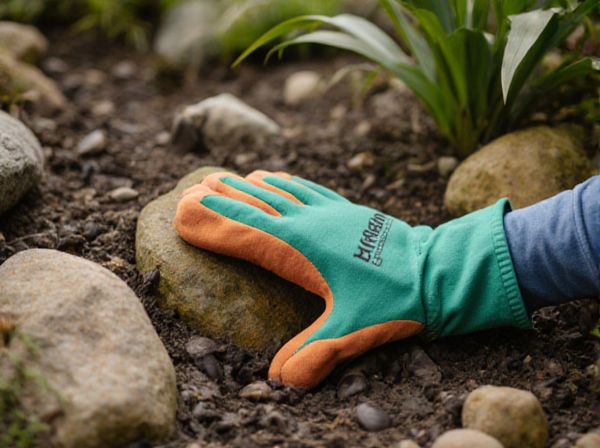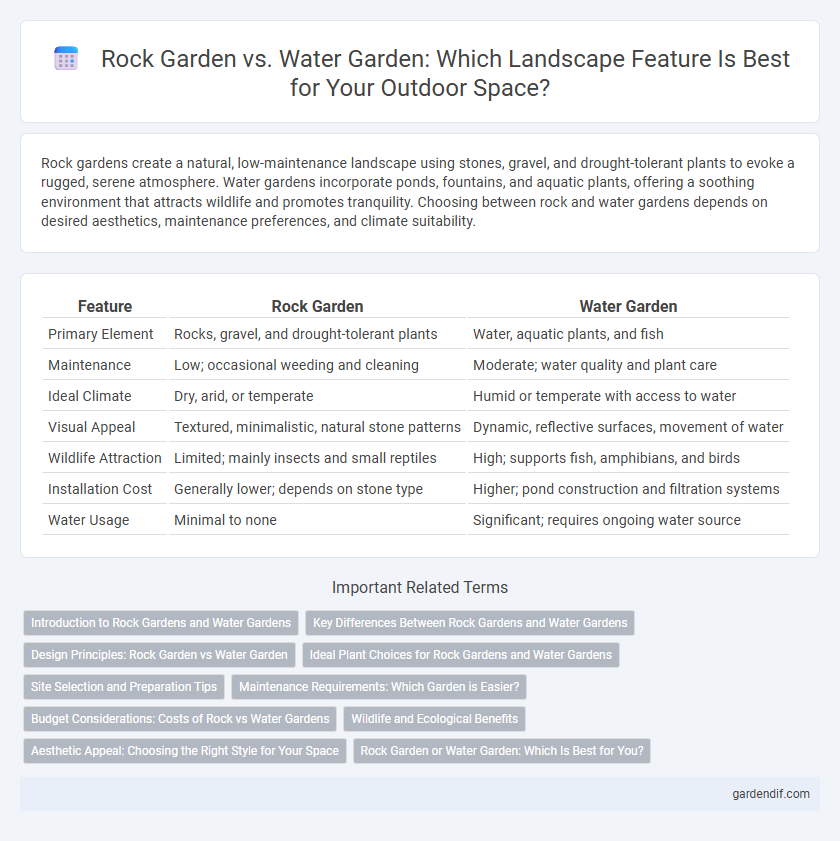
Rock Garden vs Water Garden Illustration
Rock gardens create a natural, low-maintenance landscape using stones, gravel, and drought-tolerant plants to evoke a rugged, serene atmosphere. Water gardens incorporate ponds, fountains, and aquatic plants, offering a soothing environment that attracts wildlife and promotes tranquility. Choosing between rock and water gardens depends on desired aesthetics, maintenance preferences, and climate suitability.
Table of Comparison
| Feature | Rock Garden | Water Garden |
|---|---|---|
| Primary Element | Rocks, gravel, and drought-tolerant plants | Water, aquatic plants, and fish |
| Maintenance | Low; occasional weeding and cleaning | Moderate; water quality and plant care |
| Ideal Climate | Dry, arid, or temperate | Humid or temperate with access to water |
| Visual Appeal | Textured, minimalistic, natural stone patterns | Dynamic, reflective surfaces, movement of water |
| Wildlife Attraction | Limited; mainly insects and small reptiles | High; supports fish, amphibians, and birds |
| Installation Cost | Generally lower; depends on stone type | Higher; pond construction and filtration systems |
| Water Usage | Minimal to none | Significant; requires ongoing water source |
Introduction to Rock Gardens and Water Gardens
Rock gardens feature carefully arranged stones and drought-tolerant plants like succulents and alpine species, creating a naturalistic, low-maintenance landscape element. Water gardens incorporate aquatic plants such as lilies and lotus, combined with ponds or flowing water features to promote biodiversity and a serene ambiance. Both garden types offer unique aesthetic and ecological benefits, enhancing outdoor spaces through contrasting textures and sensory experiences.
Key Differences Between Rock Gardens and Water Gardens
Rock gardens emphasize drought-tolerant plants and mineral elements, creating a low-maintenance landscape with textured stones and succulents. Water gardens feature aquatic plants, ponds, and fountains, promoting biodiversity and a tranquil ambiance with fish and water lilies. While rock gardens rely on earth tones and arid conditions, water gardens focus on moisture-rich environments and dynamic water movement.
Design Principles: Rock Garden vs Water Garden
Rock gardens emphasize the use of rocks, gravel, and drought-tolerant plants to create textured, low-maintenance landscapes that evoke natural mountainous terrain. Water gardens prioritize aquatic plants, reflective surfaces, and water features like ponds or fountains to establish a tranquil, dynamic environment that supports wildlife. Design principles for rock gardens center on balance, contrast, and natural appearance, while water gardens focus on flow, harmony, and ecological integration.
Ideal Plant Choices for Rock Gardens and Water Gardens
Succulents, alpine plants, and drought-tolerant perennials like sedum, lavender, and thyme thrive in rock gardens due to their ability to withstand well-drained, nutrient-poor soils and sun exposure. Water gardens benefit from aquatic plants such as water lilies, lotus, and cattails, which flourish in submerged or consistently moist environments while providing habitat for aquatic wildlife. Incorporating native species like creeping jenny in rock gardens and pickerel weed in water gardens enhances ecological balance and sustainability.
Site Selection and Preparation Tips
Rock gardens require well-drained, slightly sloped sites with ample sunlight and minimal soil moisture to prevent root rot, emphasizing the use of sandy or gravelly soil for optimal drainage. Water gardens thrive in flat, low-lying areas with natural or artificial basins that retain water, necessitating impermeable liners and careful site grading to avoid water leakage and soil erosion. Proper site analysis and soil amendment are crucial for both garden types to ensure plant health and long-term sustainability in landscape design.
Maintenance Requirements: Which Garden is Easier?
Rock gardens demand minimal maintenance, requiring occasional weeding and pruning of drought-tolerant plants, making them ideal for low-effort landscaping. Water gardens necessitate regular care including water quality management, algae control, and seasonal cleaning to maintain aquatic plant health and avoid stagnation. Comparing both, rock gardens are generally easier to maintain due to fewer requirements for constant monitoring and intervention.
Budget Considerations: Costs of Rock vs Water Gardens
Rock gardens typically involve lower initial costs, requiring mainly rocks, soil, and drought-tolerant plants, making them an affordable landscaping option. Water gardens demand higher expenses due to the need for pumps, liners, filters, and ongoing maintenance costs associated with water features. Budget-conscious homeowners should weigh the upfront installation and long-term upkeep costs when choosing between rock and water garden designs.
Wildlife and Ecological Benefits
Rock gardens provide essential habitats for drought-tolerant species, including various reptiles, insects, and pollinators, promoting biodiversity in arid environments. Water gardens support aquatic and semi-aquatic wildlife such as frogs, dragonflies, and birds, enhancing local ecosystems by improving water quality and offering breeding grounds. Both garden types contribute to ecological balance by supporting distinct wildlife communities and promoting native plant growth tailored to specific environmental conditions.
Aesthetic Appeal: Choosing the Right Style for Your Space
Rock gardens create a rugged, natural aesthetic with textured stones, drought-tolerant plants, and earthy tones that complement minimalist or rustic landscapes. Water gardens offer a serene, reflective surface through ponds or fountains, enhancing tranquility with aquatic plants, colorful fish, and the soothing sound of flowing water. Selecting between these styles depends on whether you prefer the dry, structured beauty of rock formations or the dynamic, calming presence of water features in your outdoor space.
Rock Garden or Water Garden: Which Is Best for You?
Choosing between a rock garden and a water garden depends on your landscape's climate, maintenance preferences, and aesthetic goals. Rock gardens thrive in dry, sunny environments, requiring minimal water and offering year-round structure with drought-resistant plants and decorative stones. Water gardens create a serene focal point with aquatic plants and fish, needing more upkeep and suitable for areas with natural water access or irrigation.
Rock Garden vs Water Garden Infographic

 gardendif.com
gardendif.com